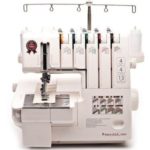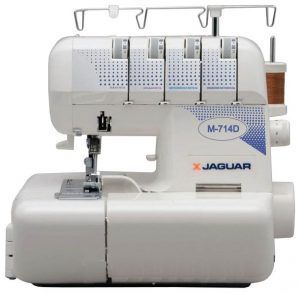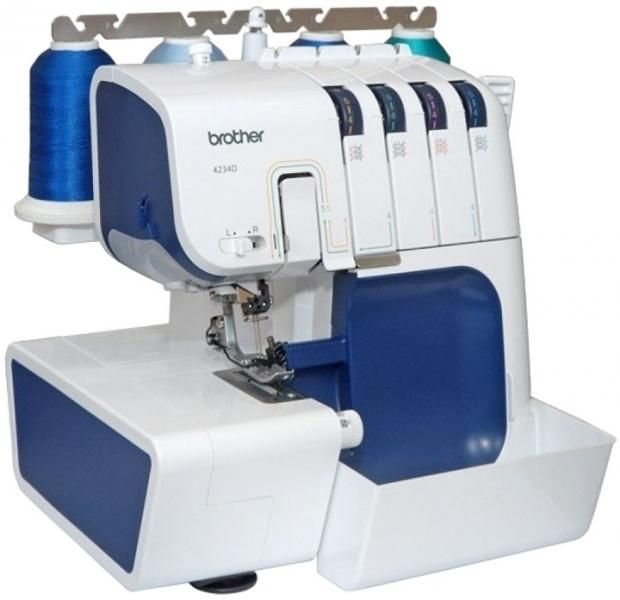What is overlock
Scientific and technological progress does not stand still, and affects even such trivial, at first glance, devices as sewing machines. How not to get confused in complex terms and make the process of sewing clothes easier? How can an overlocker help in this matter and what is it? Is it possible to buy a sewing machine that is already equipped with an overlocker?
The content of the article
What is an overlocker and why is it needed?
An overlocker is a specialized sewing machine that allows you to simultaneously cut off excess threads and overcast the edge. A seam made using such a device can be found on any factory-made clothing. It usually uses from two to five threads, depending on the type of fabric.
Important: the overlocker is intended only for trimming fabric and overcasting the edges of the material.
 An inexperienced seamstress may confuse an overlocker, a coverlocker (a sewing machine that combines a coverstitch machine and an overlocker) and a coverstitch machine or coverstitch machine (used for sewing from highly stretchy fabrics. For example, knitwear allows you to sew a panel without cutting). However, it is quite easy to distinguish them visually. The smallest for the “sleeve” is just for the overlocker, since it is intended only for overcasting and cutting threads.
An inexperienced seamstress may confuse an overlocker, a coverlocker (a sewing machine that combines a coverstitch machine and an overlocker) and a coverstitch machine or coverstitch machine (used for sewing from highly stretchy fabrics. For example, knitwear allows you to sew a panel without cutting). However, it is quite easy to distinguish them visually. The smallest for the “sleeve” is just for the overlocker, since it is intended only for overcasting and cutting threads.
Overlock in a sewing machine
An ordinary sewing machine is not capable of combining several types of seams with an overlock stitch.However, there is an opinion that there are sewing machines with overlock, and people who do not understand these devices ask store clerks to sell them just such a thing. This misconception is explained by the fact that the first machines that could make a zigzag seam were also used to process the edges of clothes using this seam. But in reality, the overlock stitch is far from it, and has completely different functions.
Overlock elements that are widely used when sewing a product:
- Possibility to automatically tighten the threads. One of the beauties of an overlocker is that you can set it so that the threads are automatically tensioned when you need them. Most often these are machines with a computer interface. However, for an experienced seamstress, it will not be difficult to tighten the threads by hand - it is quick and easy.
- Setting the stitch width allows you to control the seam and make it tighter where needed.
- The ability to turn the seam into waves - this function will allow you to decorate an item (for example, sleeves or the edge of a blouse) and is indispensable when sewing skirts or dresses.
- The ability, if necessary, to turn on or off the knife, which cuts off excess fringe and threads at the edge of the product.
- Roller stitch, widely used for finishing the edges of cap sleeves and flounces.
Please note: some beginners purchase an overlocker as a sewing machine. This is fundamentally wrong: it is intended only for processing seams and edges of the product, but in no case for sewing directly. Of course, this rule does not work for knitted items - due to the fact that an overlocker can sew the edges of fabrics, those who use only knitwear and stretch fabrics in sewing can only get by with it.
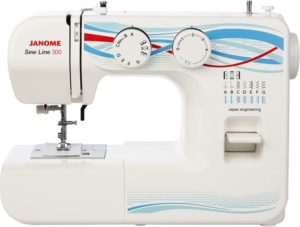 Is it possible to do without it, but with just one sewing machine? You can use a special overlock foot for sewing machines. Such a foot, of course, will not replace all the functions of an overlock machine, but will allow you to perform basic seams. An overlock foot, unlike a machine one, has a special rod that allows you to control the thread tension. Thanks to this, the seam when sewing will be much neater and more beautiful. The disadvantage of such a foot is that it is unable to completely replace an overlocker - although the seam will look similar in appearance, it still needs to be repeated using a regular straight stitch on a machine.
Is it possible to do without it, but with just one sewing machine? You can use a special overlock foot for sewing machines. Such a foot, of course, will not replace all the functions of an overlock machine, but will allow you to perform basic seams. An overlock foot, unlike a machine one, has a special rod that allows you to control the thread tension. Thanks to this, the seam when sewing will be much neater and more beautiful. The disadvantage of such a foot is that it is unable to completely replace an overlocker - although the seam will look similar in appearance, it still needs to be repeated using a regular straight stitch on a machine.
Important: if you want to purchase an overlock foot, first check if your machine already has one. If not, then don’t try to buy the first one you come across - manufacturers of sewing accessories make overlock feet specifically for certain brands of sewing machines. In principle, it doesn’t matter which foot you buy, since the principle of operation is the same for everyone.
What does it consist of?
A standard household overlocker has two loopers and looks like a sewing machine. It has two knives - upper and lower - for cutting off excess threads. There is also an upper and lower looper, a handwheel, a presser foot and a needle (the number depends on the type of seam). The overlocker is enclosed in a housing that is attached to the work surface using legs.
Despite the fact that overlockers can use from two to five threads, a regular overlocker used for sewing clothes at home or in a small studio has four threads. Unlike a classic sewing machine, the thread from the overlock spool immediately goes into the loopers, bypassing the bobbin.Due to this, the machine creates a very special stitch, similar to a complex braid, which is difficult to create on a simple sewing machine. When using an overlocker, you need to be prepared for the fact that the thread consumption will be very high. This is explained not only by several coils at once, but also by the technique of weaving the stitch itself.
Important: due to the high thread consumption on an overlocker, it is much more profitable to purchase large spools of thread in packages at once.
Possibilities
What are the advantages of an overlocker? Is it worth purchasing it or can you do without it? You can sew without an overlocker - this is what many seamstresses have been doing for many years, sewing seams on a regular sewing machine. When should you buy an overlocker:
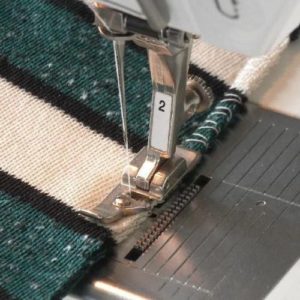 you are planning to do professional sewing or sew to order: most clients want to get something that is not just similar to the factory one, but even of higher quality, so you can’t do without professional seam processing.
you are planning to do professional sewing or sew to order: most clients want to get something that is not just similar to the factory one, but even of higher quality, so you can’t do without professional seam processing.- Most of the fabrics from which the products are made are knitwear? Overlock in such cases is simply a necessary thing. The same applies to stretch items: bodysuits, swimsuits, as well as costumes for performances and some sports, for example, figure skating, rhythmic gymnastics, synchronized swimming.
- for those who care about the inside of the item, you also need to purchase the necessary tools and materials - the impression of even a nice-looking T-shirt can be spoiled by an unsuccessful seam.
Types of seams
Using an overlocker you can create many different seams, however, we will look at the most popular options:
- Double-thread chain stitch, which is widespread and is often used to decorate the finished product. Can be used for stretchy items.
- Flatlock seams in a variety of widths, ideal for hemming T-shirts and T-shirts.
- The three-thread stitch is one of the most common, which allows you to beautifully complete the edges of the product.
- Four-thread reinforcement stitch.
Why is it still worth purchasing an overlocker? The seams of a sewing machine and an overlocker are very different. Of course, you can overcast the edge using a sewing machine: first delay the edge with a zigzag, and then stitch it again. However, if you compare such overcasting from photographs, it becomes obvious that overlock seams for overlocking are not comparable in appearance to machine stitching.
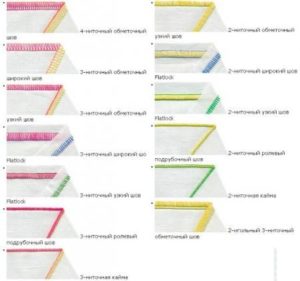
Although the appearance of an overcast stitch made on a machine can imitate an overlock stitch, it is enough to carelessly pull the fabric a few times (and this is inevitable when worn), and you can say goodbye to the seam - it will simply burst, and you will have to start all over again. If you think that you can get by with just an overlock foot, then don’t delude yourself – the quality of a seam on a machine is not comparable to an overlock stitch. That is why even the smallest ateliers and professional seamstresses working to order have this wonderful machine, which makes their range of possibilities even wider.
When choosing an overlocker, focus on the company and the number of threads used - four or five - exactly what you need. The fact is that multi-thread overlockers can be easily transformed into two-thread or three-thread overlockers - this way you acquire a multifunctional device, killing two birds with one stone. Also, multi-thread devices also have several stitching programs - this is also a definite plus. Using an overlocker, you can select a stitch depending on the type of fabric - cotton, stretch or knitted.
Whether to purchase an overlocker or not, everyone decides for themselves. If you sew a lot for yourself and your loved ones, or take (even rarely) custom work, then you definitely need an overlocker - the quality of the seam is incomparable to that of a machine. For those who sew only for themselves from cotton, for example, it is not necessary to purchase an overlocker: you will rarely use it.



